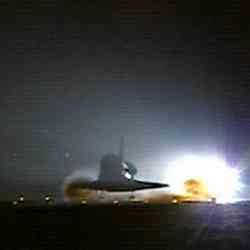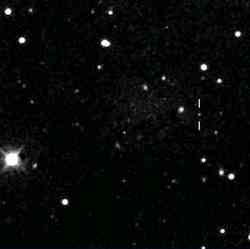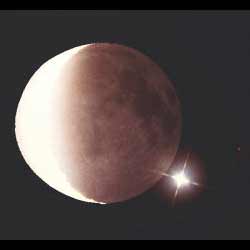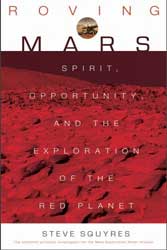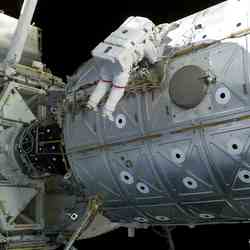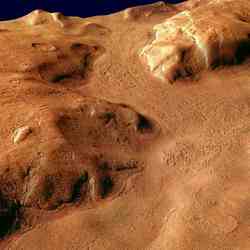
Artist illustration of the newly discovered 10th planet. Image credit: NASA/JPL. Click to enlarge.
At the same time, another team led by astronomer Mike Brown of Caltech reported they had been observing 2003 EL61 for almost a year, but were waiting to analyze data from the Spitzer Space Telescope before announcing the discovery.
“There is no question that the Spanish group is rightly credited with discovery,” Brown stated on his personal website. “Even if they had found the object only this year and announced its existence, they would still be considered the rightful discovers. We took a chance that no one else would find it while we were awaiting our observations from the Spitzer Space Telescope. We were wrong! And we congratulate our colleagues on a very nice discovery.”
But just hours after that, Brown announced to the media the discovery of two other big TNOs, designated as 2003UB313 and 2005 FY9. Regarding the first one, he stated that it’s about three times as far from the Sun as Pluto, and “it’s definitely bigger” than the ninth planet.
Brown’s team discovered 2003 ub313 on January 8th, but wanted to further analyze their observations. However, they “were forced to announce their results on Friday evening because word had leaked out” he said.
“In mid-July, short abstracts of scientific talks to be given at a meeting in September became available on the web. We intended to talk about the object now known as 2003 EL61, which we had discovered around Christmas of 2004, and the abstracts were designed to whet the appetite of the scientists who were attending the meeting. In these abstracts we call the object a name that our software automatically assigned, K40506A -the first Kuiper belt object we discovered in data from 2004/05/06, May 6th-. Using this name was a very very bad idea on our part.”
“Unbeknownst to us, some of the telescopes that we had been using to study this object keep open logs of who has been observing, where they have been observing, and what they have been observing. A two-second Google search of “K40506A” immediately reveals these observing logs”.
According to Brown, from the moment the abstracts became public, anyone with an Internet connection and a little curiosity about the “K40506A” object could have found out where it was.
Brown was quick to point that he believes the fact that this discovery happened days after the data were potentially available on the Web is a coincidence. But “some people in the community privately expressed their concerns to me that this coincidence was too good to be true and wanted to know if there was any possible way that anyone could have found out the location of our object,” he added.
At this point, Brown contacted Brian Marsden at the International Astronomical Union’s Minor Planet Center (MPC). Brown told him confidentially about the two objects not yet announced (2003 UB313 and 2005 FY9), expressed his concerns that someone might be able to find their data and attempt to claim credit for discovering these objects, and sought advice.
Marden found that someone had already used the website of the MPC to access past observations of one of the objects and predict its location for that night. The past observations were precisely the logs from the telescope that Brown’s group had been using. “We had no choice but to hastily pull together a press conference which was held at 4pm on the last Friday in July, perhaps the single best time to announce news that you want no one to hear”, said Brown.
However, some astronomers have a very different opinion about Brown’s announcement.
“The group of Dr. Brown decided, as in previous cases, not to make public its detection until they finished their observations and their research work, and until the object was in conjunction with the Sun so that other people couldn’t observe it,” stated Dr. Javier Licandro in an e-mail sent to a Spanish-speaking astronomy mailing list. Licandro works at the Isaac Newton Group of Telescopes and the Instituto de Astrof?sica de Canarias, in Spain.
“They did it before with Sedna. But this time, by taking this ‘doubtful’ risk, they lost all the rights on the discovery of that object. Even more, their policy is, at least, criticizeable.”
“Due to the detection of 2003 EL61 by Ortiz et. al., and because of the fiasco that this has represented for Brown et. al., they decided to go public ‘ipso factum’ with their discoveries of two other objects that they knew at least from six months ago, 2005 FY y 2003 UB313,” said Licandro.
Contacted by AstronomiaOnline.com, Brown wouldn’t want to elaborate on Licandro’s comments. “I like Javier. It is unfortunate he feels the need to make such remarks,” he said.
But it didn’t take long for Ortiz to air his own feelings about the situation. “With technology many times more advanced than our own, Brown’s team had discovered three big objects many months ago, but they were hiding their findings from the international scientific community, as they did before with Quaoar and Sedna,” he declared to the Spaniard paper ABC.
“This secrecy was useful to Brown, as it allowed him to study the object in detail and exclusively. But his actions harm science and don’t follow the established procedures that imply notifying the existence of a new object to the astronomical community as soon as it’s discovered,” added Ortiz.
Brown indicated that he didn’t get that statement from Ortiz himself, so he would not want to comment on it directly. However, asked again by AstronomiaOnline.com, he said: “In general, there certainly are people who have that opinion, to which they are entitled. I, however, cannot think of any area of science in which an ‘established procedure’ is to announce a discovery with no time for thought and analysis. Anyone who feels otherwise is welcome to go and find these objects themselves -as did Ortiz- and get the credit for their own discoveries.”
Written by Ricardo J. Tohmé for Astronom?aOnline. If you want to read the original article in Spanish, click here.


